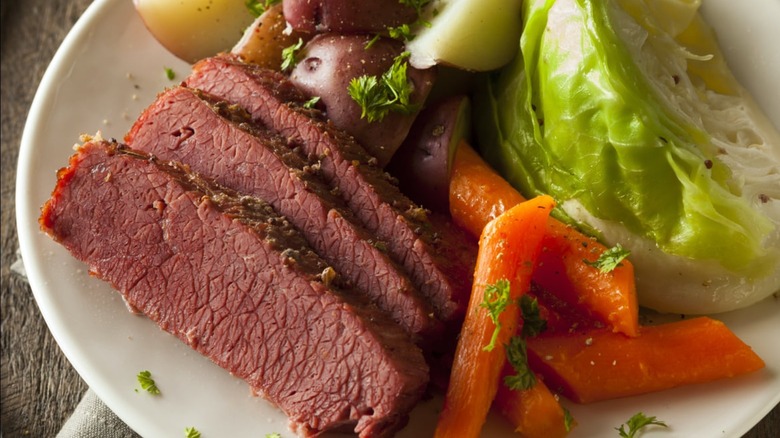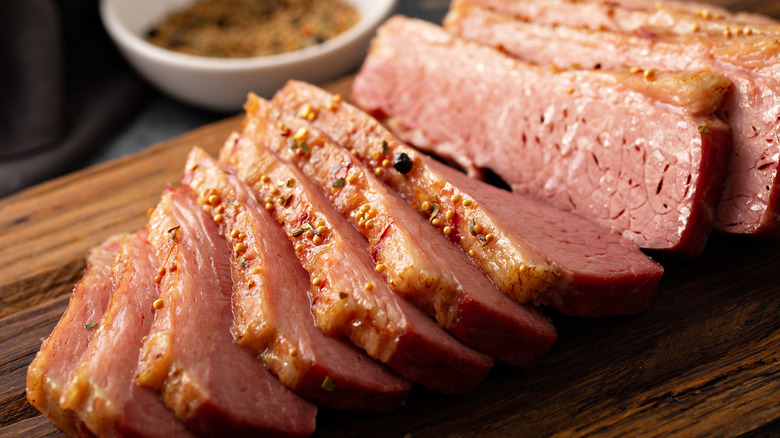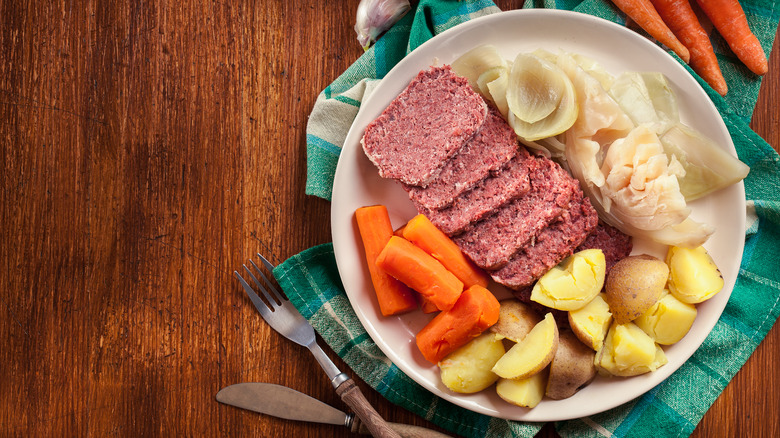The Truth About The 'Corn' In Corned Beef
As March 17 approaches, many people feel a wee bit Irish. Even if a devilish leprechaun pulls a prank or two, the promise of a hearty corned beef and cabbage dinner to celebrate St. Patrick's Day is a welcome feast. Although this traditional food has become a holiday staple, the name corned beef can be a slight misnomer. The corn is not that yellow ear featured at many summer barbecues.
Sometimes food descriptors can be misleading. Although not every phrase is an oxymoron, like jumbo shrimp, the reality is that words can only do so much to describe that flavor experience, visual appearance, or just create some anticipation of the food on the plate. Even if corned beef has nothing to do with corn on the cob, people can instantly picture that plate of food. A rich red colored meat that is perfectly tender. Whether people love it or prefer to enjoy it just on the Irish holiday, there is no mistaking that it is an iconic dish.
How did corned beef become associated with the Irish?
Many foods are forever associated with a particular country or region. Who doesn't think of croissants and France or guacamole and Mexico? When it comes to corned beef, many people instantly think of Ireland and St. Patrick's Day. That said, as the History Channel noted, the traditional food celebration for the feast of St. Patrick often involved Irish bacon and cabbage — not corned beef.
Though corned beef wasn't always front and center amid St. Patrick's Day festivities, The Kitchn revealed that because Ireland was a major producer of salted meat, and churned out large amounts of corned beef, it became associated with the dish. And while corned beef was once thought to be a luxury and too expensive for much of the Irish to enjoy, it ultimately got less expensive and by the 19th century, it was not only a favorite of Irish-Americans, but a staple of St. Patrick's Day celebrations.
What is the corn in corned beef?
While corned beef might seem associated with Ireland, the exact origins of this food associated with St. Patrick's Day has strong ties to Great Britain. According to the Smithsonian Magazine, during the 17th century, the British imported Irish cattle for its consumption. Since people wanted to ensure that the beef lasted as long as possible, salt was used for preservation.
Since Britain imported large amounts of Irish cattle, the practice of "corning" the beef became popular. According to the The Takeout, the term corn refers to the size of the salt crystals, which resembled the size of a corn kernel. There is no relation to the vegetable and no ears of corn are used in making corned beef. Simply, salt is rubbed into the meat for preservation.
Given the size of the salt, the beef became cured, not just salted beef. Over time, the usefulness of the corned beef was widely accepted. From being used on long journeys to some people just enjoying the taste, the flavor of the now iconic dish is rooted in history.
How is corned beef made today?
While many people can picture that plate of corned beef, the process is slightly different from the original idea that started in the 17th century. According to the USDA, brining is more often used than "corning." Beef is submerged in a salt brine (water and salt combined) which both flavors and tenderizes the beef. Although the process is more like a pickle, the original name has stuck.
Sometimes, the corned beef has more flavors than just the salt. Some recipes today include peppercorns or a bay leaf. The brine allows more flavors to be absorbed by the beef, which helps to create that classic flavor.
Often corned beef is served with traditional sides. According to The Tasting Table, the usual side dish is cabbage, but it doesn't have to be the only vegetable on the plate. From potatoes to carrots to even peas, there is a bounty of options to try. But, the key is to balance flavors on the plate. When there is harmony on the plate, the feeling of good cheer around the table will be evident — even if that glass of Irish whiskey is empty.



